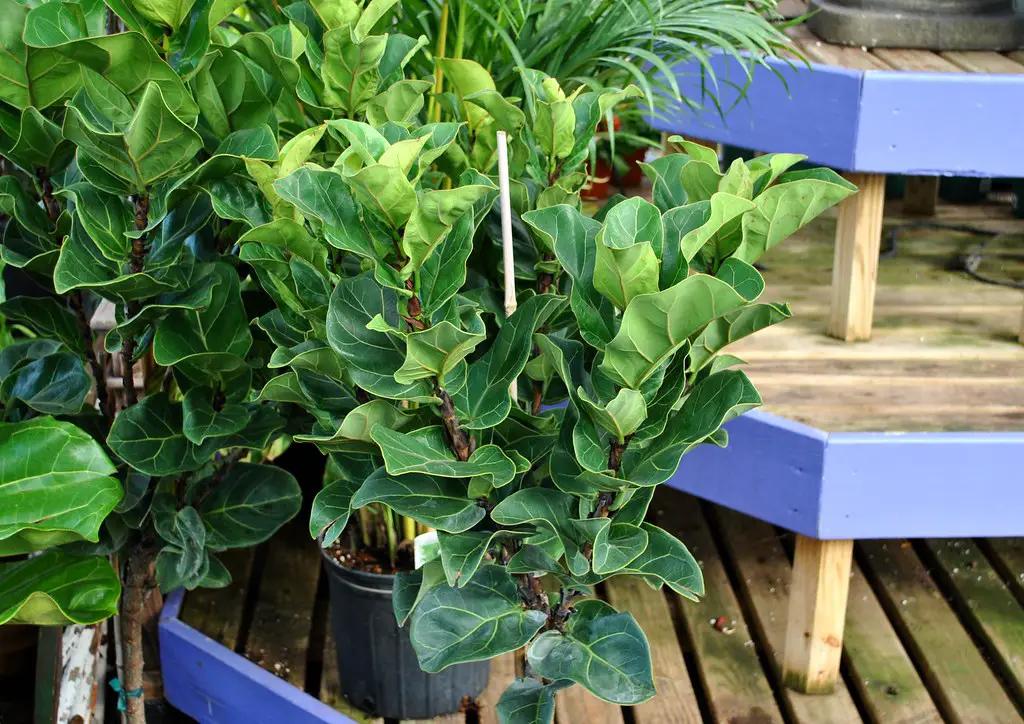The Fiddle Leaf Fig, scientifically known as Ficus lyrata, is a popular and trendy houseplant that has captured the hearts of many plant enthusiasts. Named for its large, violin-shaped leaves, this attractive plant has become a favorite in interior design, adding a tropical and modern touch to homes and offices.
Native to the tropical rainforests of Western Africa, the Fiddle Leaf Fig grows naturally as a tall tree. However, when cultivated indoors, it can be managed as a smaller tree or shrub. Its lush, deep green leaves make it a visually appealing choice, but it’s also known for being slightly finicky. The plant demands specific care, thriving in certain light, water, and soil conditions.
Despite its specific needs, the Fiddle Leaf Fig’s impressive appearance makes the extra care worthwhile. It’s not only a beautiful addition to any space but also offers air-purifying qualities, absorbing indoor pollutants like formaldehyde.
| Attribute | Details |
|---|---|
| Common Names | Fiddle Leaf Fig, Ficus lyrata |
| Botanical Name | Ficus lyrata |
| Family | Moraceae |
| Plant Type | Evergreen Tree or Shrub |
| Mature Size | 5-10 feet (indoors) |
| Sun Exposure | Bright, indirect light |
| Soil Type | Well-draining, loamy soil |
| Hardiness Zones | 10-12 |
| Native Area | Western Africa |
Fiddle Leaf Fig Care
Caring for a Fiddle Leaf Fig is not as daunting as it may seem. What’s crucial is understanding its specific needs and mimicking its natural tropical habitat. This entails providing it with plenty of indirect sunlight, consistent watering, and the right soil mix.
The Fiddle Leaf Fig is known for being sensitive to changes in its environment. Therefore, once you find a spot where it thrives, it’s generally best to keep it there. Regular monitoring for pests and diseases, along with proper fertilization and pruning, can keep the plant healthy and thriving.
Light Requirement for Fiddle Leaf Fig
The Fiddle Leaf Fig prefers bright, indirect sunlight. A spot near a north or east-facing window is often ideal. Too much direct sunlight can cause the leaves to burn, while too little light may cause the leaves to lose their rich green color.
Soil Requirements for Fiddle Leaf Fig
A well-draining soil mixture that retains some moisture is perfect for a Fiddle Leaf Fig. A mixture of standard potting soil with some perlite or sand can achieve the desired balance. The soil must be kept moist but never soggy, as this can lead to root rot.
Water Requirements for Fiddle Leaf Fig
Watering the Fiddle Leaf Fig should be done when the top inch of soil is dry. It’s essential to avoid overwatering, which can lead to root rot. Providing a consistent watering routine and checking the soil regularly will help in maintaining the right moisture level.
Temperature and Humidity
The Fiddle Leaf Fig enjoys a warm and humid environment. It thrives in temperatures between 65-75°F (18-24°C) and appreciates higher humidity. Avoid placing it near air vents or drafty windows.
Fertilizer
Fertilizing the Fiddle Leaf Fig during the growing season with a balanced, water-soluble fertilizer every 4-6 weeks helps in maintaining its lush growth. It’s best to refrain from fertilizing during the winter months.
Pruning Fiddle Leaf Fig
Pruning helps in shaping the Fiddle Leaf Fig and maintaining its health. Removing dead or damaged leaves and cutting back any overly long stems can encourage bushier growth.
Propagating Fiddle Leaf Fig
Propagating the Fiddle Leaf Fig can be done through stem cuttings. Taking a cutting with a leaf or two and placing it in water or moist soil can result in a new plant.
How To Grow Fiddle Leaf Fig From Seed
Growing a Fiddle Leaf Fig from seed is a slow and challenging process, not typically recommended for the casual home gardener.
Common Pests & Plant Diseases
Aphids
Aphids can be treated with insecticidal soap or neem oil.
Mealybugs
Removing mealybugs manually or treating with insecticidal soap is effective.
Root Rot
Caused by overwatering, adjusting watering habits and repotting with fresh soil can resolve this issue.
Common Problems With Fiddle Leaf Fig
Drooping Leaves
This can be a sign of overwatering or underwatering. Adjusting the watering schedule according to the soil’s dryness can rectify the problem.
Brown Edges
Low humidity or too much sunlight may cause brown edges on the leaves. Modifying the plant’s location or increasing humidity can help.
Yellow Leaves
Overwatering is often the culprit for yellow leaves. Monitoring soil moisture and watering appropriately can bring the plant back to health.
Pro Tips
- Keep the Fiddle Leaf Fig in a consistent location where it thrives.
- Water when the top inch of soil is dry.
- Clean the leaves regularly to remove dust and allow for better photosynthesis.
- Rotate the plant every few weeks to ensure even growth.
- Monitor for signs of pests and diseases and address them promptly.




